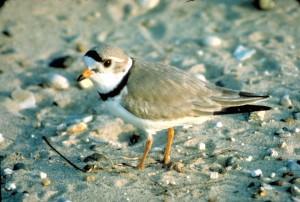Editors note: Congress is considering a $475 million appropriation for Great Lakes cleanup. This story is part of an occasional look at proposals for spending it. Is this appropriate? Weigh in on this and other ideas on Echo’s Great Lakes Restoration Initiative forum. Other stories.

Great Lakes island conservation efforts may help protect the piping plover, an endangered shorebird in the Great Lakes region.
By Sarah Coefield
coefield@msu.edu
Great Lakes Echo
July 29, 2009
The birds living on Great Lakes islands may be cut off from the mainland, but they are surrounded by its threats. Invasive species, contaminants and encroaching housing and business development spell trouble for the millions relying on islands for safe-havens and nesting grounds.
Federal officials hope to add protection for some of those feathered island dwellers as part of new environmental protection funding considered by Congress for the Great Lakes.
The U.S. Fish and Wildlife Service seeks $1.5 million for island habitat conservation as part of the $475 million Great Lakes Restoration Initiative. The money would be used to inventory plants and animals and to buy conservation easements or property to add to nearby island wildlife refuges.
There are more than 31,000 islands in the Great Lakes, and Matt Sprenger, a refuge supervisor for the fish and wildlife service and one of the leaders on the island project, admits the new funding won’t stretch to cover all. But, he said, it’s a start. For now the service will focus on islands in lakes Superior, Michigan and Huron that are close to wildlife refuges, he said.
An important step is to study the islands themselves.
“There’s probably just the tip of the iceberg in terms of what we know on the islands and the unique species and benefits associated with those island habitats,” Sprenger said. The federal agency plans to identify vegetation and spot nesting water birds from the air. That information helps target islands for preservation.
What little is known about the Great Lakes islands is that they’re special.
They provide unique habitat to birds that can’t live elsewhere, said Dave Ewert, a senior conservation scientist with the Great Lakes Region Nature Conservancy. Because the islands are typically free of bird-hunting mammals, they provide a safe-haven for many birds, including the piping plover, a shorebird that is endangered in the Great Lakes region. Vast colonies of double-crested cormorants thrive on the islands. So do colonies of Caspian terns, common terns and egrets. Migrating songbirds rely on islands as safe places to refuel during their long journeys.
“In each of those ways, I think islands play a very special role and unique role that just can’t be done on the mainland, especially the colonial nesting water birds,” Ewert said. The Nature Conservancy has been working with federal officials to protect Great Lakes islands since the late 1990s.
The islands are “globally rare and precious,” said Karen Vigmostad, the director of the U.S.-Canada Great Lakes Islands Project. They comprise the world’s largest collection of freshwater islands and provide critical habitat to nesting and migrating birds. They are also threatened by habitat destruction, contaminants and invasive species. Islands are fragile ecosystems because plants and animals have a hard time getting on and off them, Vigmostad said.
To identify which islands need protection, U.S.-Canada Great Lakes Islands Project members, who include representatives from Canadian and U.S. government agencies and nature conservancies, spent the past six years creating a database with information on each of them. They ranked the islands on such things as threats, biodiversity and protection status. The goal, Vigmostad said, is to funnel the database resources to groups already doing island conservation work. Vigmostad expects the database will be out of peer review and accessible to the public by the end of this year.
For Vigmostad, protecting Great Lakes islands means protecting the planet. “In order to preserve biodiversity around the globe, in general, to have a healthy Earth, to have healthy diversity of species, they’re important in and of themselves to conserve,” she said.
The biodiversity and wildness of Great Lakes Islands is something I was unaware of until just recently, but I think it’s going to be a big story in the next five years.
There’s an opportunity to learn more Aug. 28-30 at the Great Lakes Islands Symposium on Beaver Island. Kind of a great excuse to head to the island. You can get more info here:
http://www.miseagrant.umich.edu/workshops/glislands2009
Or email me at stephaa@umich.edu